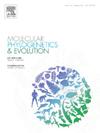基因分型测序阐明了Veronica亚群中乌克兰分类群的种限。Pseudolysimachium。
IF 3.6
1区 生物学
Q2 BIOCHEMISTRY & MOLECULAR BIOLOGY
引用次数: 0
摘要
维罗妮亚属。pseudoolysimachium主要分布在欧亚大陆的自然和半自然草地上,是Veronica地区多样化率最高的植物之一,因此很难从其多样性热点区划分物种边界。为了解决其乌克兰成员的物种限制,该小组的欧洲多样性热点,我们结合了GBS,生态位建模,孢粉学和形态计量学的证据,并比较了三个密切相关物种的气候生态位。我们证实了维罗妮卡和紫锥菊是不同的物种。这两个分类群,尽管以前在很大程度上被忽视,在系统发育中代表了独立的谱系,并以独特的形态特征组合为特征。相较于它最近的亲戚,薇罗妮卡(Veronica steppacea),薇罗妮卡适应更干燥、更大陆性的气候,这突出了欧亚草原带的地带性在塑造该亚属多样性方面的重要性。维罗妮卡被分为两个地理上不同的分支,提供了具有蛛网状被毛的植物在亚属中出现两次的证据。另外两个乌克兰分类群,V.gryniana和V.incana亚种。Hololeuca可能是杂交起源。本文章由计算机程序翻译,如有差异,请以英文原文为准。

Genotyping-by-sequencing elucidates the species limits of Ukrainian taxa within Veronica subg. Pseudolysimachium
The subgenus Veronica subg. Pseudolysimachium contains mostly species occurring in natural and seminatural grasslands throughout Eurasia and is characterized by one of the highest diversification rates within Veronica, making it difficult to outline species boundaries, especially in taxa from its diversity hotspots. To resolve species limits among its Ukrainian members, the European diversity hotspot of the group, we combine evidence from GBS, niche modeling, palynology and morphometrics and compare the climatic niches of three closely related species.
We confirm that Veronica maeotica and V. steppacea are distinct species. Both taxa, even though previously largely ignored, represent independent lineages in the phylogeny and are characterized each by a unique combination of morphological traits. Veronica steppacea is adapted to a drier, more continental climate than its closest relative, V. barrelieri, highlighting the importance of the zonality of the Eurasian steppe belt in shaping the diversity of the subgenus. Veronica incana is split into two geographically distinct clades, providing evidence that plants with a cobwebby indumentum arose twice within the subgenus. Two other Ukrainian taxa, V. gryniana and V. incana subsp. hololeuca, may be of hybrid origin.
求助全文
通过发布文献求助,成功后即可免费获取论文全文。
去求助
来源期刊
CiteScore
7.50
自引率
7.30%
发文量
249
审稿时长
7.5 months
期刊介绍:
Molecular Phylogenetics and Evolution is dedicated to bringing Darwin''s dream within grasp - to "have fairly true genealogical trees of each great kingdom of Nature." The journal provides a forum for molecular studies that advance our understanding of phylogeny and evolution, further the development of phylogenetically more accurate taxonomic classifications, and ultimately bring a unified classification for all the ramifying lines of life. Phylogeographic studies will be considered for publication if they offer EXCEPTIONAL theoretical or empirical advances.

 求助内容:
求助内容: 应助结果提醒方式:
应助结果提醒方式:


